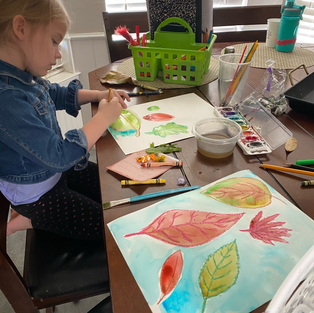Play and Learn with Plants
- Megan Hoskins
- May 19, 2020
- 2 min read
Updated: May 21, 2020
Our family "Plant Week" took place in mid March. The wildflowers were in full bloom all along our Texas highways, and it seemed like the perfect time to study some of the diverse flowers, stems, leaves, and roots in our neighborhood.

We started our week with a walk and a bucket. I let the kids collect as many different plant parts they could find from as many (appropriate) places along our walk. We made sure to only choose plant parts that were unwanted by our neighbors- weeds, fallen leaves, sticks, etc. When we got home, I grabbed an old box from the garage, tore it apart, and used one panel as a plant bulletin board.

The kids helped me sort and tape the plant parts up to our board.
We chose these categories:
Leaves
Stems/Branches
Cones, Seeds, Berries, and Fruit
Flowers
Roots
Other
A board like this is the perfect launching point to start discussing the different plant structures and their jobs.

Roots and Seeds:
To study seeds and roots, we did some planting. These little plastic pots came from Dollar Tree, but any container will do. We chose to plant pumpkin seeds, because of course, that's what I had on hand (buried in a junk drawer from the previous fall). Miraculously, our pumpkin seeds germinated and sprouted within a few weeks.
While waiting for your plants to sprout, you can read some books about plants. The Tiny Seed by Eric Carle is a great one! You can also watch a timelapse of a bean growing. So cool!

Stems:
To study stems, we pulled some celery, water, and food coloring out of the kitchen.
After only a few hours, you could already see the dye going up the celery stalk. By the next morning, the leaves were each colored a different hue.
With this experiment you can talk with your children about stems bringing water and nutrients all the way up to the leaves and flowers. You can also discuss the stem's job of holding the plant up to get more sunlight, one of its essential needs.
Leaves:
Next, came the study of leaves. A fun way to include leaves in sensory play is to let children make leaf molds with clay or play dough. This helps little hands explore the sizes, shapes, and textures of leaves while building motor skills. We liked holly leaves best in our molds. They left the deepest and clearest impressions with their stiff edges and veins.
Another fun artistic medium to try with leaves is crayon relief. All you have to do is draw leaf outlines and vein patterns with a crayon, then fill in with watercolor. It was fun to choose which leaves we wanted to paint from our collection. My daughter especially loved mixing all of the colors in the background. She was so proud of her artwork!
Flowers:
To explore flowers, we decided to just take a drive. We went out in a field and found as many different wildflowers as we could, being careful not to pick anything we shouldn't or disturb any wildlife.

We came home and used dot painters to paint some of the flowers that we found. Then, we looked up some of the amazing folktales associated with our area's native wildflowers.

I hope you and your family learned a lot and had some plant-astic fun together! Comment with your experiences and ideas if you have a chance!










Comments